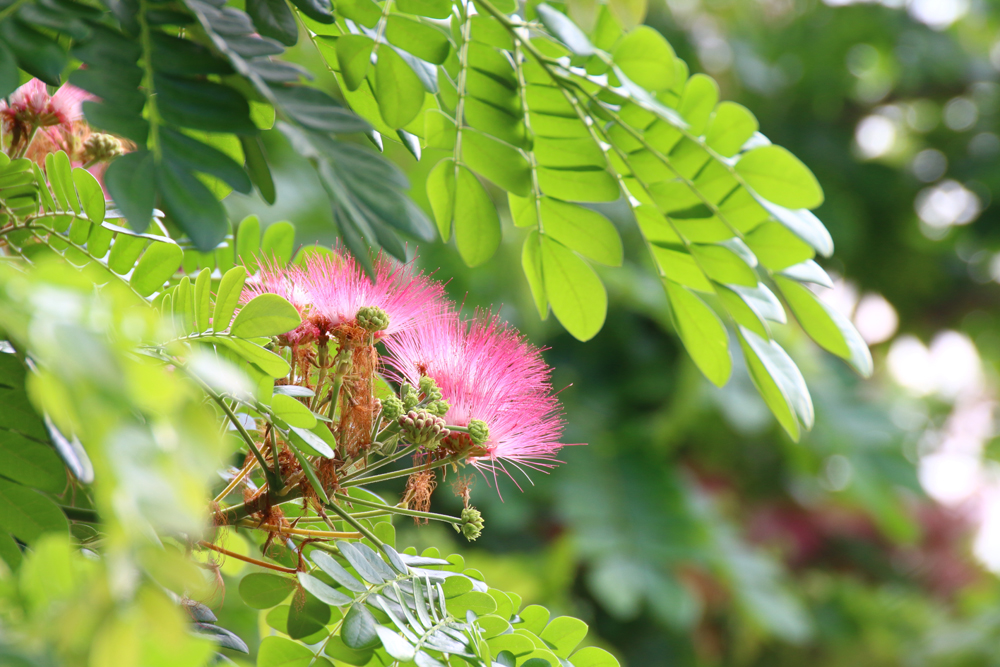Pithecolobium (Pithecellobium) flexicaule
Common Name:
Texas Ebony

General information:
This 15 to 30-foot-tall evergreen tree is native to Texas and Mexico and is ideal for use in dry, desert landscapes. The short branches are clothed in very small, dark green leaflets and make up a 15 to 20-foot-wide rounded canopy which casts medium shade below. Short thorns are interspersed among the branches. From June to August, Texas Ebony is decorated with dense, plume-like spikes of very fragrant, light yellow to white blossoms at the ends of branches. The dark brown to black, woody seed capsules which follow are four to six inches long and persist on the tree. In Mexico, the seeds from these pods are eaten, and the black woody shells have been known to be roasted as a coffee substitute in times past. The attractive, short trunk of Texas Ebony is covered with smooth, grey bark. It makes a nice medium-sized shade tree.
The literature uses two slightly different names for this species: Pithecolobium or Pithecellobium which is Greek for monkey and ear-ring. It is known as Texas Ebony, Mexican Ebony or False Acacia. Flowers generally occur at the ends of branches. The bark is not remarkable, being smooth and without significant markings. The leaves are small, dark green, bi-pinnate (compound), arranged on a 1 inch to 2 inch long stems. Leaves fold up at night or in subdued light. Touching the leaves does not put it to sleep as in some mimosa.
Family:
Leguminosae
Lighting:
Thrives in full sun but will adjust to less light conditions.
Temperature:
Zones 9B through 11. Tropical, but will stand a light frost. Because it is tropical, it does not go fully dormant, but it does rest, then grows some more, then rests.
Watering:
Mature trees will tolerate mild drought but lacking a tap root, will not appreciate having too long a time between drinks. Young specimens should not be permitted to remain dry.
Feeding:
Monthly with any soluble fertilizer.
Pruning and wiring:
Suitable for many styles. As a bonsai the small evergreen leaves give a pleasing sense of proportion. It will do very little branching until it is older unless strongly encouraged by being top pruned repeatedly while under 12 inches tall. Growth rate slows considerably after reaching 12 - 18 inches height. Because it has a slow growth rate it tolerates wiring without easily incurring wire damage and it requires less frequent trimming and repotting. Leaf size may be significantly reduced with careful attention to watering, light and pinching. Mature trees show a disposition toward upward growing branches. Cropped short they make nice pads of foliage above the major branch. There are few, in any, downward growing branches. It will break back on old wood.
Propagation:
Seeds in the wild are frequently infected by a small weevil. However, viable seeds are easily germinated. Soak for 24 hours, then cut out a tiny piece of the outer shell with the tip end of a concave pruner or with a file. Soak again for 24 hours. Sow on the surface of a rooting medium. Prior to transplanting, remove the tap root. Because of the large tap root they are difficult to collect in the wild.
Repotting:
Its native soil is neutral to mildly alkaline. It is very hardy and will accept a wide variety of soil mixes provided acidity is not allowed to develop. Roots tend to intertwine and should be unraveled when repotting.
Pest and diseases:
No pests or diseases are of major concern. Be careful not to over-irrigate.
Bibliography:
“Another Indoor Bonsai” by Edith Sorge, Bonsai Journal (ABS), Vol 10, No. 2, pg 32, 44 (1976).
“Bonsai - The Art and Technique” by Dorothy S. Young, Prentice-Hall, 1985, pages 373 4.
“More Notes on Texas Ebony” by Glade and Harold Krivoy, Bonsai (BCI),Vol 18,
“Texas (1980).
“Texas Vol 16,
“Texas Journal
The Standard Cyclopedia of Horticulture by L. H. Bailey, The Macmillan Co., 1947, pages 2651-3.
No. 6, page 186 (1979)
Ebony” by Glade Krivoy, Bonsai (BCI), Vol 19, No. 7, page 239
Ebony” by L. A. Byrd, Jr, Bonsai (BCI), Vol 18, No. 3, page 95 (1979)
Ebony as Bonsai Material” by Lawrence E. Brown, Bonsai (BCI), No. 6, page 196 (1977).
Ebony - Pithecellobium flexicaule” by Ernesta Ballard, Bonsai
(ABS), Vol 14, No. 1, pg 5-6 (1980). USDA Fact Sheet ST-483
Compiled by Thomas L. Zane
